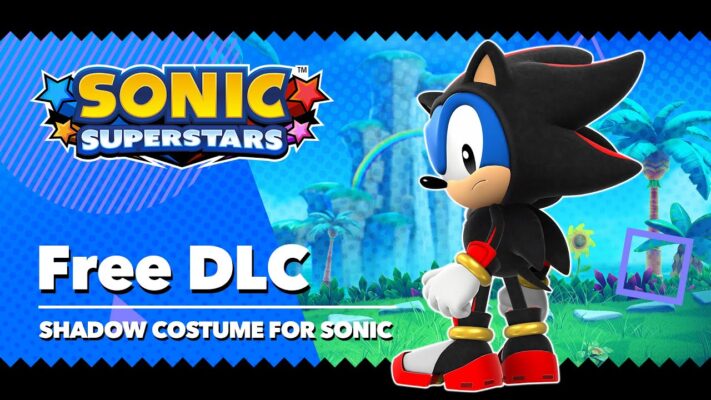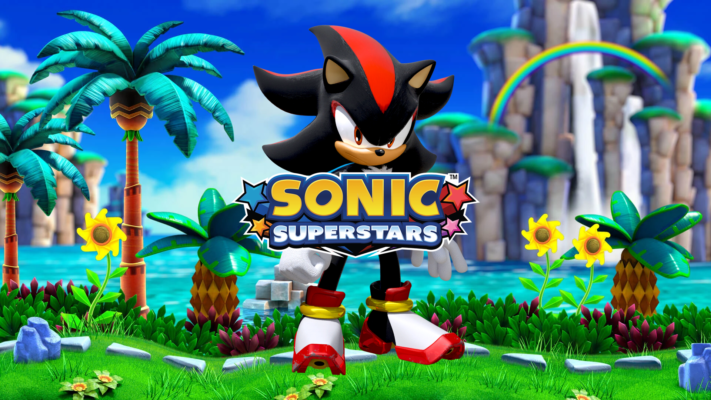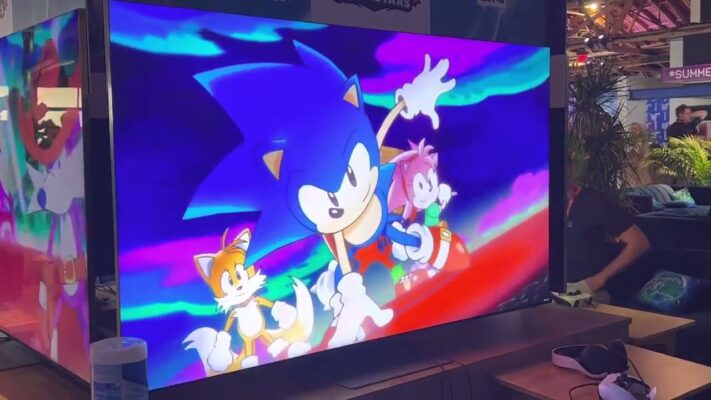Sonic Superstars
Scheduled for release on October 17th.
Prices: Regular Edition: 6,589 yen Digital Deluxe Edition: 7,689 yen

Action game, Sonic Superstars for PlayStation 5/PlayStation 4/Xbox Series X|S/Xbox One/Nintendo Switch/PC (Steam/Epic Games Store) is finally nearing its release on October 17th.
This game is developed with the concept of evolving the classic 2D Sonic. While it allows for the old-fashioned gameplay and enjoyment, it also incorporates new elements like cooperative play for four people and special abilities like the Emerald Powers. It becomes the latest installment in the Sonic series, offering both new and classic features.
At the Tokyo Game Show 2023 venue, trial booths were set up, and many fans enjoyed playing the game. This time, there was an opportunity to hear from Sonic series producer Takashi Iizuka and development producer Naoto Ohshima about the key points of this game at the venue. I’d like to deliver the details of that conversation.
Developed With the Concept of evolving 2D Sonic, Sonic Superstars
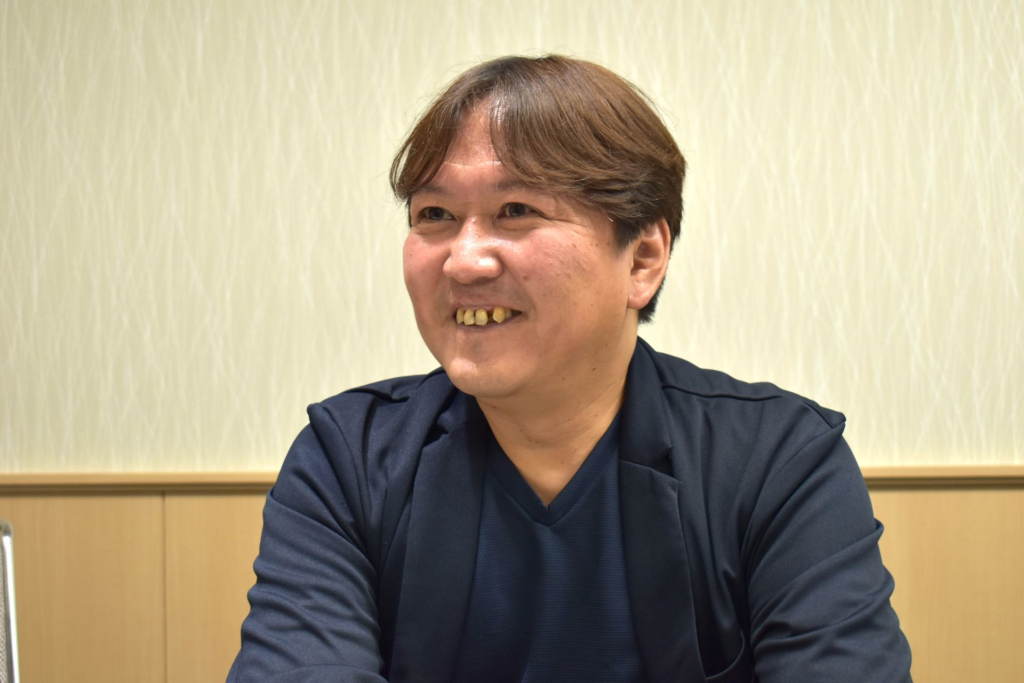

――First, please tell us about the concept of this game.
Iizuka-san: The Sonic series has been going on for over 30 years, with 2D Sonic and 3D Sonic as the two major pillars of this ‘Sonic’ brand.
Last year, with Sonic Frontiers, we significantly evolved 3D Sonic and laid the groundwork for further development. This time, the concept is the other pillar, which is the 2D side-scrolling Sonic. While maintaining the gameplay of traditional 2D Sonic, the concept involves expressing what has always been presented in pixel art and dot graphics in a modern 3D graphical style, aiming for significant changes.
――What was the catalyst for the concept of evolving 2D Sonic?
Iizuka-san: The catalyst was Sonic Mania. The Classic series had concluded with the Mega Drive, but when we re-released Sonic Mania in 2017, keeping it in pixel art, we received tremendous positive feedback from the fans. It made us realize once again, ‘Classic Sonic still has this much demand.’ That led us to plan further development based on that and resulted in this project.
――The character design in this game is quite different from pixel art. Could you tell us about the dedication to this aspect?
Iizuka-san: This time, as it’s a new entry in the Classic series, we wanted to preserve the direction taken in the previous titles: 1, 2, 3, CD, and then Mania. We felt it was crucial to adhere to this direction because we believe that deviating from it would greatly disappoint traditional fans. So, we started this project with the conviction of preserving this aspect at all costs.
Of course, since we couldn’t use any of the previous programs, ARZEST and Ohshima-san’s team had to recreate the exact behaviors from scratch, relying on eyeballing to match the movements. Even the in-game character animations were reproduced in 3D to perfectly mimic the movements from the pixel art of that time. Initially, we asked them to take the step of ‘running the Classic series entirely on a 3D graphics engine.’
――While it seems like you could have explored new expressions, I sensed a strong dedication to faithfully replicating the Classic series’ movements.
Iizuka-san: There are titles like Sonic Mania and Sonic the Hedgehog 4, which brought the gameplay of modern Sonic into the 2D realm. That came out around 2010, but what sets Sonic Mania apart overwhelmingly is the player’s behavior. When fans saw Sonic Mania and said, ‘This is 2D Sonic!’ we felt the need to preserve that. It’s the sentiment of ‘Let’s uphold this, let’s not betray the Sonic fans who have been with us throughout Sonic’s long history.’
On the other hand, with games like Sonic Frontiers, part of the modern Sonic series, we create them with the intention of incorporating new elements and continuously evolving. However, since this is squarely within the Classic series this time, we’re adopting an approach where we preserve what needs to be preserved.
――I had the opportunity to play the trial version exhibited at TGS this time. I played the two stages, ‘Pinball Carnival’ and ‘Cyber Station.’ In Pinball Carnival, there was a sense of speed where I bounced around and couldn’t keep up with everything, and in Cyber Station, there were moments where it switched to pixel art, characters spinning around, creating a different kind of expression. While gameplay-wise it remains 2D, there are expressions utilizing depth, and I felt it was a new challenge.
Iizuka-san: That’s precisely what we’re aiming for. We’ve set the minimum baseline for elements that need to be preserved from the Classic series, such as behaviors and animations. From there, we incorporate new elements into the stages, the Emerald Powers, and such aspects to create it with the intention of bringing out the ‘Sonic essence.’
So, even in Pinball Carnival, while it includes the element of Sonic-themed pinball that’s familiar, it’s designed as an entirely new stage. The idea of turning into a mouse or a jellyfish in Cyber Station came from Ohshima-san.
――I think those kinds of new ideas aren’t just an extension of 2D Sonic.
Ohshima-san: I’m always thinking about new things… (laughs). So, effortlessly, I just put in the things that come to mind.
Back when I was creating Sonic in the past, I used to naturally come up with new ideas and seamlessly incorporate them. Since we were the ones who initially created Sonic, I actually designed the pinball stage in the first game. It’s that feeling of ‘Should we power it up this time?’
――Are there any gimmicks on the stages that you’d like people to take notice of?
Iizuka-san: It’s a bit challenging to single out a gimmick and say, ‘This is so interesting, please take a look, give it a try.’ However, since this game is entirely new, we’ve incorporated elements that anyone, at a glance, would recognize as part of a Sonic game, while expressing everything with entirely new gimmicks and visuals. We’ve introduced gimmicks that feel like they belong in Sonic while being entirely new.
Also, it’s about the sense of speed. I believe this time around, there are more gimmicks and level designs focused on speed, offering a greater sense of speed than in the traditional Classic series.
――From the perspective of level design, this game also features multiple routes for stage completion, correct?
Iizuka-san: That’s a critical aspect, the core of Classic Sonic’s level design philosophy. In the case of 3D modern Sonic, there are limitations to expressing multiple routes.
However, in 2D Sonic, when players see an upper route, they tend to move upwards, but they can also proceed straightforwardly without going up, or even if they fall, there might be another route below. Even while casually playing, ensuring that all routes intersect and lead to the goal is crucial.
I believe this is a distinctly Sonic-like element not found in other action games. In this game, too, while working on level design, we guided the level designers, teaching them, step by step, ‘This is how Sonic’s level design should be done.’
――So, you’re incorporating new expressions while also emphasizing the importance of Classic Sonic’s level design, visuals, and character movements.
Iizuka-san: The level designers who worked on Classic Sonic during the Mega Drive era, well, I’m the only one left at Sega, you know (laughs). So, if I don’t pass on my knowledge to someone, the Classic series might die out. That’s why this time, I worked with ARZEST, guiding them on how to create a great Classic Sonic game.
――I believe this game features 4-player cooperative play. There’s a possibility that through cooperative play, players might discover routes that the development team didn’t anticipate.
Iizuka-san: For instance, since Sonic 3, there’s been the action where Tails can carry Sonic and fly in the air. As I mentioned earlier, there are plenty of routes in Sonic, both upwards and downwards. So, even if Tails carries Sonic in cooperative play, just the fact that they can access the upper routes means it won’t pose a problem if Sonic is carried away. Because Sonic is a game with multiple routes, actions like Tails flying or Knuckles climbing walls have been incorporated into level designs that can withstand such actions.
――In 4-player cooperative play, if everyone uses an Emerald Power, it’s possible to overpower bosses and such, isn’t it?
Ohshima-san: This is my interpretation, but we’ve talked about Sonic having various routes, right? So, Sonic is a game where players engage in time attacks. Players might discover routes that we never imagined, and they clear levels with incredible speed.
In other words, as level designers, we’re like Eggman, and players and Eggman are in a battle. Eggman, or the developers, create stages thinking, ‘When a character comes here, I’ll do this, I’ll place energy here, I’ll set a trap here.’ But on Sonic’s side, players have Tails, who can fly in the air, Knuckles, who can climb walls and glide. Players conquer stages in various ways; that’s what ‘Sonic’ is about.
Eggman’s team is working hard to challenge the players, but then players might think, ‘Let’s clear it by using the Emerald Powers.’ As the stages progress, they become more challenging, prompting players to think, ‘Let’s change characters for this part,’ or ‘Let’s use abilities to progress.’ Even users who prefer to enjoy it traditionally without using special abilities will find it enjoyable. Therefore, we deliberately avoid closing off areas where shortcuts might be found, so even if we find shortcuts, we won’t block them off.

――There are various types of Emerald Powers, aren’t there? During my play at the demo, I experienced ‘Bullet,’ which allows dashing in mid-air.
Iizuka-san: “Vision” is one of the abilities available in the demo. Vision allows you to see things that are otherwise invisible. When used, it reveals platforms that are normally unseen, plenty of hidden rings, and other concealed elements. When previously invisible platforms become visible, it leads to discovering routes that were otherwise inaccessible.
Emerald Powers can be used or not used for progression. To guide players on when to use them, there’s an indicator in the bottom right of the screen that suggests when it might be beneficial to use them. For instance, if it advises using ‘Vision’ at a certain point, it means there’s something hidden there. By following these hints, players can explore new routes or discover new strategies.
――For instance, after progressing through the game, acquiring various Emerald Powers, is there an element where upon replaying cleared stages, there are new discoveries?
Iizuka-san: Absolutely. We haven’t designed the stages in a way that once you clear them once, they’re finished. There are various hidden elements that players can still discover even after clearing a stage.
Emerald Powers are collected in the series’ common ‘Special Stage’ area. Once you obtain an Emerald, if you revisit previous stages, you might discover alternative strategies or pathways you hadn’t noticed before.
――How many types of Emerald Powers are there?
Iizuka-san: As most players might already know, there are seven Chaos Emeralds, and there’s a corresponding power for each of those emeralds. Additionally, when you collect all seven, as an extra bonus, you gain an additional power—the familiar transformation ability—so including that, there are a total of eight powers.
――The Chaos Emeralds are hidden throughout the stages, so the idea is to progress while searching for them, right?
Iizuka-san: Each Special Stage follows the same rules but presents a different layout. For instance, they have distinct placements or paths for the emeralds, providing seven unique stages.
These Special Stages have time limits, and they’re set relatively strict. Collecting the floating rings within the stage adds time. The early stages are straightforward, but they get increasingly challenging as you progress.
If you fail, you have to replay the stage and find the Big Rings (objects that lead to the Special Stages). However, you can retry as many times as needed, so I think it’s considerably easier to collect them compared to the classic series from the past.
――Older titles had a reputation for being quite challenging. Regarding the difficulty level and retries in the Special Stages, have they been adjusted to be more forgiving to align with modern gaming standards?
Iizuka-san: As it’s an action game, in terms of the satisfaction derived from gameplay, the latter stages provide quite a bit of challenge. The early stages are relatively accessible. One significant difference from classic games of the past is that this time, there’s no ‘Game Over.’
In the past, it used to follow an arcade-style ‘lives’ system, so after a few defeats, it was ‘Game Over’ and back to the beginning. In this game, there’s no ‘Game Over,’ so even if you make mistakes multiple times, you can restart from the same stage, making it considerably more forgiving.
――Could you tell us about the volume of stages and content?
Iizuka-san: We haven’t disclosed specific numbers yet, but among the titles in the traditional classic series, I believe this game offers the most extensive volume of gameplay.
――The stages revealed so far have had different themes. Are there any other stage themes that you can share?
Iizuka-san: I’m afraid I can’t share information that hasn’t been revealed yet… (laughs).


Details About the Battle Mode, Where Three Out of Four Rules are Selected From, Have Also Been Revealed
――Please tell us more about the playstyle of the Battle Mode.
Iizuka-san: This is an entirely separate mode from the main game. Offline, it allows up to four players with a split-screen, while online, it supports up to eight players globally on a full screen.
The unique aspect is the battle rules, with a total of four short-duration battle stages. Let me explain each in order.
Firstly, there’s the ‘Race.’ This is a straightforward rule where the goal is to reach the finish line quickly. Next is the ‘Star Collection.’ Stars appear within the map, and the aim is to collect as many as possible.
Then, we have ‘Survival,’ where there are floors that drop, and the objective is to survive without falling as long as possible.
Finally, there’s ‘Fighting.’ This involves direct combat between characters, throwing projectiles at each other. Three out of these four rules are randomly selected.
Players compete in three rounds, and the one who accumulates the most points overall becomes the winner of the Battle Mode.
――It’s surprising to hear about battles involving Sonic.
Iizuka-san: The characters participating are robots called ‘Metal Fighters’ created by Eggman. It’s a competition between these robots, and it’s tied to the main storyline as well. (laughs)
Ohshima-san: There are fans of characters like ‘Metal Sonic’ or ‘Metal Knuckles,’ and they can create their customized Metal Fighter.
Iizuka-san: Customization is available. When you win, you receive medals, and by collecting these, you can purchase parts, change the head or the legs, essentially creating your ideal Metal Fighter. For instance, you can have Metal Sonic’s body with a different head, like Mecha Sonic. There’s that level of customization.
Of course, there are numerous parts available, and if you purchase the Digital Deluxe Edition, you’ll get an additional set of metal parts.
Ohshima-san: The battles themselves are enjoyable, and collecting medals for custom parts adds more fun, making it playable for a long time.
Iizuka-san: Throughout the main gameplay, you can collect quite a few medals. Starting with purchasing customization parts, playing the Battle Mode for an extended period will further accumulate medals.
――Is there any aspect from the battles that can be brought into the main storyline?
Iizuka-san: No, there isn’t. The battles remain separate from the main storyline.
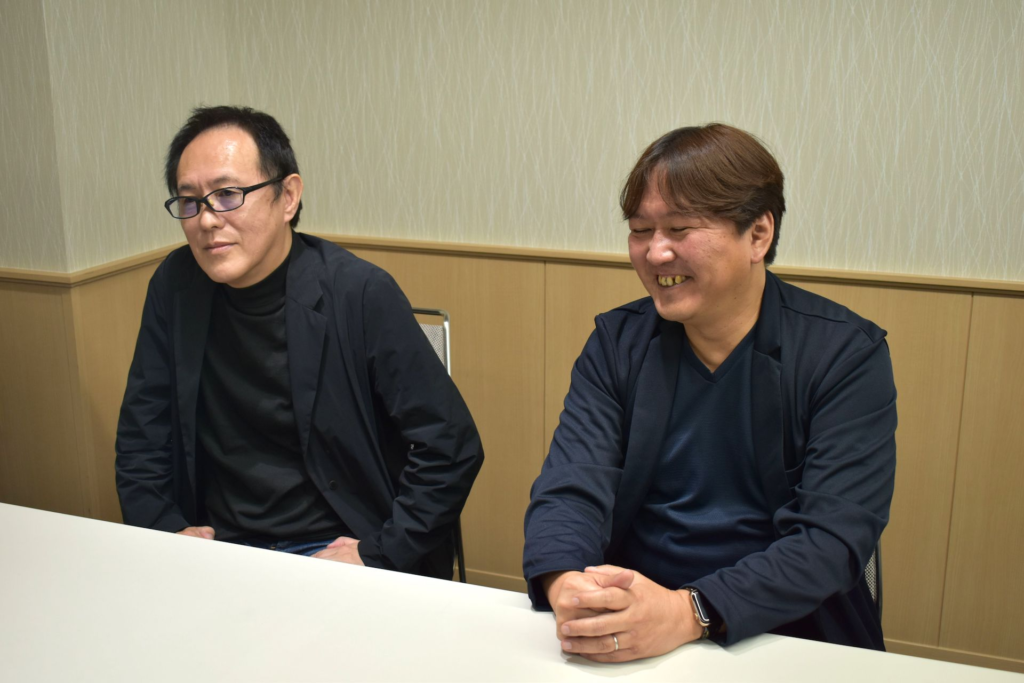
World Maps Make an Appearance in this Game. There’s Also Something Called ‘Act Fruits,’ Which Function Akin to Bonus Stages
――Is there anything else you haven’t mentioned?
Iizuka-san: As an element deliberately not mentioned in trailers and such, there’s something called the “World Map.”
In the typical classic Sonic series, it progresses from Act 1 to Act 2, and so on in a sequence. In this game, you can certainly play in that manner, but you also have the option to return to the World Map and select your favorite stages from a menu.
Within the World Map, there are shortcuts to buy custom parts, a sub-mode to learn the controls of all characters through tutorials, and there’s also something called “Act Fruits,” which hasn’t been talked about much (laughs).
As you free animals in the main story, you occasionally obtain fruits. By having these fruits, you can access special bonus stages called Act Fruits on the World Map. It’s like consuming one fruit for one play in these special stages. I think this is something players might not notice unless they return to the World Map.
Ohshima-san: There are capsules where small animals are captured, and it’s set up like a roulette. If it lands on the section with fruits, you can obtain them.
――What can you do in Act Fruits?
Iizuka-san: Essentially, it’s a bonus game where you collect rings. It’s designed to be a multiplayer-friendly game for up to four players.
In the main story’s multiplayer, if one person moves ahead, the other three are automatically iconized and follow along. It’s a rule specific to the speedy gameplay. Act Fruits, however, involves a forced-scrolling screen where everyone collects rings, creating a mode that’s easy to play with four people.
Ohshima-san: In the main story, collecting 100 rings gets you a medal. Accumulating these medals and using them to create your customized Metal Fighter for battles provides motivation.
Iizuka-san: The motivation for playing extensively lies in collecting these medals.
Ohshima-san: Especially in Act Fruits, since you can obtain more rings compared to the main story, it becomes easier to gather medals.
The Key to the Story Lies With the New Character ‘Trip’
――Please tell us more about the story.
Iizuka-san: We haven’t showcased this much in trailers or demos yet, but the new character ‘Trip’ is a key character in the story mode.
As antagonistic characters, we have Dr. Eggman, the revived Fang the Hunter, and one more character, a girl wearing a brown mask named Trip. While Eggman and Fang have the appearance of villains, this character Trip wears a mask, has a charming personality, is a bit clumsy, and doesn’t seem like a typical villainous character. The role she plays in the story and why she’s siding with Fang and the others will be key elements in the story mode.
――On the official website, it roughly says ‘To stop Eggman’s ambitions and restore peace to the islands, they gather at the North Star Islands.’ However, I suspected there was more to it than just that.
Iizuka-san: We can say that Trip is key here.
Ohshima-san: So far, in the Sonic series, rather than defeating enemies outright, they help free little animals trapped inside the enemies. Eggman uses the life force of these animals to power his enemies.
This time, the North Star Islands are habitats for giant creatures. Eggman captures these giant creatures, places them in capsules, and constructs giant mechs to take down Sonic and his friends.
Iizuka-san: That’s Eggman’s goal.
Eggman hires Fang to gather these giant creatures from the islands. The reason why Trip supports Fang is something to look forward to in the story.
As it’s a classic series, there are no text or voiced cutscenes. We tell the story using a puppet show, a format typical of the classics. It’s not a very complicated story, just something that can be conveyed within the scope of this method to hopefully have users say, ‘That was good.’
To complement this story, we recently released an animation created in the US. It portrays why Eggman, Fang, and Trip come to this island and their purposes in a short story format.
Also, before the launch, there’s a bit… I can’t say more (laughs). However, we are creating content that introduces the story to everyone before the launch, besides the game. The rest is a secret for now (laughs).
Furthermore, aside from puppetry, we introduced animations to enhance the story. Telecom Animation Film produced the opening animation. It’s a 2D animation to supplement the opening and ending, utilizing the power of such media to expand the story.
――Fang is a character that appeared quite a while ago, right? Will other characters from past games also make an appearance?
Iizuka-san: When embarking on this project, there was always the intention to reintroduce classic series characters who haven’t been in the spotlight for some time. This idea stemmed from the positive reception when Mighty and Ray were introduced as playable characters in Sonic Mania. Following that same trend, we aimed to bring back classic characters for this game and hence chose Fang.
Other classic series characters apart from Fang won’t be making an appearance in this installment.
――It’s early to say, but in future Classic Series releases, is there a possibility of seeing more of these characters?
Iizuka-san: Yes, indeed. We aim to continue the Classic Series, and if given the opportunity, we’d like to introduce classic characters that haven’t yet appeared in the series.
The Challenge of this Game Lies in Refreshing the Appearance and Game Design While Maintaining the Traditional Gameplay
――Other than what you’ve mentioned, were there any particular challenges in this game?
Iizuka-san: In Sonic Frontiers, one significant challenge was widening the linear high-speed action of the traditional Modern series, altering the game system.
For this Classic series, it’s the opposite of Frontiers, aiming to refresh the appearance and game design while retaining the traditional gameplay. In that sense, the foundational aspect recreates the “classic Sonic” while adding new elements such as stages, Emerald Powers, and the 4P multiplayer mode. The challenge lies in incorporating these contemporary game design aspects onto that foundation. It’s about adding new elements without altering the traditional gameplay.
Regarding the Emerald Powers, typically in action games, there’s a set way to use them to clear stages or proceed further. However, in this game, you can clear stages without necessarily using the Emerald Powers. This emphasis is due to prioritizing the playstyle of the Classic series.
For new fans, there are catchy visual attacks, Sonic avatar manifestations, and various convenient actions, allowing unexpected moves, especially for those unfamiliar with the series. I believe they can enjoy the game with a fresher perspective.
Before the release, we conducted playtests involving a small group of regular players to gather feedback. Interestingly, those familiar with Classic Sonic tended not to use the Emerald Powers, while the newer generation players relied more on them to progress. This showcased the distinct playstyles, ensuring enjoyment for both sets of players.
――Is there any other element you’d like to mention?
Ohshima-san: We asked Toshihiko Masuda to be the animation director. He’s a veteran involved in an incredible number of works and has even won an Emmy Award in the past.
Iizuka-san: He was also involved in Sonic’s anime, Sonic X. For this project, we wanted to evoke a sense of nostalgia through a Japanese-style animation, so we requested Masuda-san to create the opening and ending animations.
――The opening is fun, the main game is enjoyable, and the ending is enjoyable too. It seems like an all-around enjoyable game, including the battles.
Iizuka-san: Actually, for the endings, we’ve prepared each character’s perspective separately, so I hope players can enjoy all four perspectives. Oh, I haven’t mentioned this yet (laughs).
You can change the character you play with for each stage, so if you clear the final stage with each character, you’ll see them all. There’s no need to clear each stage with every character from the beginning.
Ohshima-san: In fact, even when playing alone, Knuckles might be doing something in the background, or Tails might be defeating enemies, so all four are actively involved on the island. The endings are depicted from each character’s viewpoint since they’re all contributing together.
――Thank you very much for providing a lot of exciting information about this game! I’m looking forward to it!
Source: Game Watch


